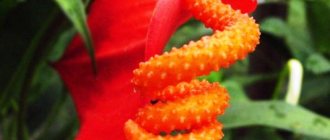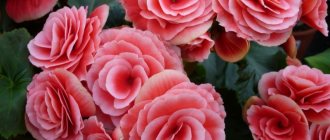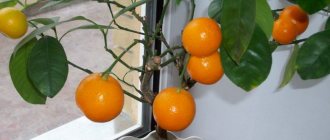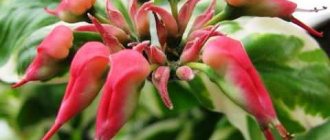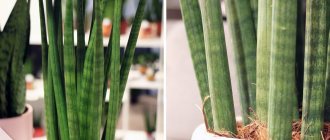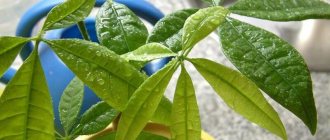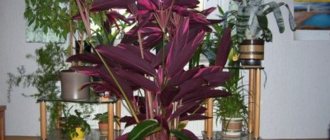Popular varieties and types of cordyline
There are more than 15 varieties of cordyline that are grown at home. The most common of them are southern, apical, fructicose, and straight.
Cordyline apex
Cordyline terminalis or apical cordyline (popularly known as the “tree of luck”) is a perennial plant with a tuber-shaped rhizome and a woody stem. It is a subshrub with a thin trunk up to 1.5 cm in diameter or a small bush up to three meters high. Young bushes have foliage from the base; at home, they remain small in size for a long time. The trunk of the tree is smooth, with traces of fallen leaves.
The leaves, which reach a width of 12 cm and a length of 85 cm, have an elongated ovate and oblong shape. In the center they have a vein that is thicker than all the others. The leaves are located on a grooved root, which reaches 12-17 cm in length.
During flowering, apical cordyline produces panicle-shaped inflorescences 35 cm wide, which are planted on a small petiole. The flowers of the plant, depending on the variety, can be purple, reddish, or white. The bush is propagated by cuttings taken from the top of the plant.
Apical cordyline has different types, which differ in the color and shape of the leaves.
Kiwi is one of the most common varieties of apical cordyline, which is a lush shrub with oblong or oval leaves up to 85 cm long and up to 12 cm wide. The leaves have a crimson border and yellow stripes along the edges. From below they narrow into a grooved root, and at the base they increase slightly. The midrib on the upper side is much larger than the others and protrudes on the underside of the leaf.
Another type of indoor cordyline is Tango. This variety is perfect for a small apartment. This is a small bush with a lush rosette of bright brown leaves, which have a crimson edge along the edge, as well as white longitudinal veins.
Cordilina straight
Cordyline stricta or straight cordyline also has other names - Dracaena cognesta or Dracaena straight. This plant is a shrub up to 3 meters tall. It has highly branched trunks in the upper part and at the same time very thin. The leaves are linear or lanceolate, up to 65 cm in size, pointed at the ends, leathery. They have rough or jagged edges and are dark green in color. During flowering, inflorescences are formed - an erect panicle with small purple flowers, which form at the top of the shoot or in the axils of the leaves. The decorative appearance of this variety is Discolor.
South Cordyline
Cordylineaustralis or Australian cordyline in natural conditions is a large tree that grows up to 25 meters in height. The trunk at the top has a bunch of narrow and long sword-shaped leaves (1 m by 4-8 cm) of a dark green color, and is thickened at the bottom. The young shrub does not have pronounced trunks. The flowers are white in color, collected in panicle inflorescences, approximately 1 cm in diameter. The size of these panicles can reach up to one meter.
In their homeland, southern cordilines are used in industrial production. This is a source of fiber, which is extracted from leaves, roots, and trunk. A wide variety of products are made from this raw material - from fabrics and mats to brushes. And the leaves of young bushes can be eaten, for which James Cook called this palm “cabbage tree.”
Southern cordyline has healing properties, as its juice is an excellent antiseptic.
The plant began to be grown in greenhouses at the end of the 19th century, and it immediately gained popularity. Various cultivars were created.
Today, the most popular varieties are Atrosanguinea, Veitchii, RedStar, Atropurpurea, which were bred in the 19th century. Their foliage ranges in color from chocolate to purple.
Cordyline fruticosis
If the shrub is located in open ground, it quickly takes on the appearance of a palm tree. However, as a decorative indoor flower, when properly cared for, Cordyline fructicosa or Cordyline fruticosa grows very slowly, retaining its leaves to the very base. It doesn't bloom in a flowerpot. Cordyline fructicosa has a large number of garden forms: Red Edge, Tricolor, Lord Roberts, Snow, Augusta and other varieties that differ in different leaf colors.
Diseases and pests
Although Cordyline is unpretentious, due to improper care it can be affected by various diseases.
- When the trunk rots and leaves are damaged, the most common problem is overwatering and root rot. In this case, the cut top of the plant is rooted.
- If the color of the leaves turns pale, the plant does not have enough sunlight.
- The appearance of extensive light spots may indicate an excess of sunlight - the plant should be shaded.
- Are the entire leaves turning yellow or are the tips drying out? The pet feels uncomfortable in a dry atmosphere.
- Very slow growth indicates depleted soil. There are two ways out - a freelance transplant with a complete replacement of the substrate or the introduction of complex fertilizing.
Cordyline pests
Main parasites:
- spider mite;
- thrips;
- scale insect;
- aphid.
It is difficult to combat pests; it is better to prevent their appearance: maintain air humidity and temperature conditions.
If parasites appear, it is recommended to wash the cordyline foliage with a soapy solution, treat the bush with an insecticide and remove the top layer of soil.
Beautiful foliage, ease of care, variety of species - all this makes Cordyline a favorite of gardeners. It will decorate any room, be it a living room in a house or a reception area in an office.
Watering
Cordyline kiwi is not as afraid of a lack of moisture in the soil as of its excess. Stagnation of water in the pot leads to rotting of the roots and death of the plant. Water fructose when the top layer of soil in the pot is almost completely dry.
In warm weather, water more frequently and abundantly; accordingly, reduce it in the cold season. Rainwater is excellent for irrigation. If you don’t have the opportunity to collect it, then boiled or well-settled tap water will do.
3.Varieties:
3.1. Cordyline terminalis
An evergreen, herbaceous, tropical plant with large, oblong-lanceolate leaves, the shades of which are very diverse - from pale pink and green to brown or burgundy, depending on the species. In their natural habitat, adult plants reach a height of 3 m. The stems are erect, do not branch, and become bare in the lower part with age, but the plant does not lose its attractive appearance.
3.2. Cordyline Kiwi
A large, decorative deciduous, herbaceous, evergreen plant, which in nature reaches a height of 2 m. The stems are erect, not branched, and with age they often become bare in the lower part. The leaves are large, oblong-lanceolate, the color of the leaves includes several tones of green, yellow and bright pink. Sometimes in the warm season, small white or lilac, sometimes purple flowers form on the plants. The variety is believed to have special frost resistance.
3.3.Southern or Australian Cordyline – Cordyline australis
In nature, it is a large subtropical evergreen tree, reminiscent of a palm tree, reaching a height of 9 m. With age, the plant forms a thick trunk, which branches into several. The leaves are hard, straight, linear, pink, burgundy, dark green, glossy, forming a lush crown at the top of the stems. The lower part of the stems becomes bare over time. Mature plants in the summer months form large drooping, branched inflorescences consisting of small white or cream flowers with a pleasant sweetish aroma.
3.4. Cordyline fruticosa
A large evergreen plant, originating from East Asia, in its natural habitat reaches a height of 4.5 m. It has long, lanceolate leaves reaching 70 centimeters in length. The flowers are white or light lilac, appear in the summer months, have a charming aroma, are collected in inflorescences - branched panicles up to 30 cm long. The shades of the leaves vary depending on the variety and can be within the range of burgundy, red, green, white or yellow.
3.5. Cordylina straight - Cordylina stricta
Quite large evergreen ornamental deciduous plants with long, green, drooping leaves, which in adult plants are retained only at the tops of slender, erect, branched stems. The leaves are glossy, reach a length of 30–50 cm, and when they fall, they leave scars on the trunks. The stems are covered with smooth, light brown bark. In its natural habitat, the plant reaches a height of 5 m. When grown at home, it remains more compact and does not exceed 2–3 m. During the flowering period, which occurs in the summer months, the plants form small, up to 1 cm in diameter, lilac flowers collected into branched panicles from 20 to 40 cm long.
3.6. Cordyline undivided - Cordyline indivisa
The evergreen tree, reaching a height of 8 mu in its natural habitat, grows slowly. With age, it forms fairly thick, erect, unbranched stems, covered with light brown bark and bearing traces of fallen leaves. In adult plants, leaves are retained only in the upper part of the stems, forming lush crowns. The leaves are green, hard, straight, reaching a length of 90 - 180 cm. In the summer months, the plants throw out drooping panicles, consisting of many small, fragrant, greenish-white or brown flowers.
You might also be interested in:
Kiwi at home
In nature, kiwi (the plant is known to botanists as Actinidia sinensis) is a tree-like vine that prefers a tropical or subtropical climate. At the tops of the shoots, whole clusters of large fruits ripen, similar in appearance to very large gooseberries. Depending on the type, they may be smooth or rough to the touch.
In nature, the kiwi vine reaches 7–10 m in length
In principle, there is nothing difficult in creating a microclimate for kiwi that is close to optimal. But the plant belongs to the category of dioecious. This means that for fruiting to occur there must be at least two specimens - male and female. They can only be distinguished during flowering. The former, acting as pollinators, lack a pistil, but have many stamens. One male plant is enough to pollinate five to six female plants. The only self-pollinating kiwi variety in existence is Jenny. But even in this variety, the presence of male plants nearby has a positive effect on productivity.
The presence of a male plant is useful even if the variety is self-pollinating
Video: how to determine the sex of a kiwi plant
Amateur flower growers value kiwi not only for its fruiting, but also for its long and abundant flowering. Large five- or six-petalled flowers gradually change color from snow-white to yellowish-cream, lemon or lime.
Fruits at home, as a rule, ripen less than the description of a particular kiwi variety promises. But in terms of the content of vitamins, macro- and microelements, and taste, they are in no way inferior to those grown outdoors. Ripe fruits are easily separated from the vine. They are stored in the refrigerator, the approximate “shelf life” is one and a half to two weeks.
“Homemade” kiwis are small but very tasty
There are no problems with obtaining kiwi seeds at home. They can be taken from any berry purchased in the store. But seedlings grown in this way rarely inherit the varietal characteristics of the “parent”, and the taste of the fruit leaves much to be desired. Therefore, they are most often used as a rootstock, and any seedling of a certain variety purchased from a specialized nursery acts as a scion.
Viable seeds can be obtained from the kiwi fruit, which can be purchased at any grocery store.
You will have to wait quite a long time for the harvest from kiwi grown from seeds. As a rule, such plants bloom for the first time no earlier than six years after planting.
It is advisable to obtain planting material from mature and healthy-looking fruits
For proper development of kiwi, warmth and sunlight are vital. Therefore, the pot is placed in the brightest place in the apartment, for example, on a south or south-west window sill, turning it periodically (every 2–2.5 weeks) so that the heat is distributed evenly. Cold drafts are strictly contraindicated. Equally important are regular fertilizing (preferably organic) and proper watering.
In nature, kiwi is a vine, so you need to take care of support for it in advance
For some reason, actinidia juice has an effect on cats (and, to a lesser extent, cats) similar to that of valerian tincture. Therefore, it is worth putting the pot somewhere where cats definitely cannot reach it, or surrounding the plant with a net.
Cats do not eat kiwi leaves and shoots, but they can severely damage the plant when trying to get to the juice, which for some reason they are very partial to.
Diseases and pests
Cordyline is one of the plants that are resistant to various diseases and pests. Perhaps the most terrible disease for any plant is root rot. The florist, trying to cheer up the drooping flower, begins to water it abundantly, which ultimately leads to a sad end - the plant dies. A timely identified symptom will help you quickly deal with the problem.
| Diseases and pests | Symptoms | Control measures | Prevention |
| Root rot | looks sluggish. The leaves gradually fade, become covered with brown spots and dry out. Growth stops. | If the disease is not advanced, you can try to save the plant.
inspect the roots and trim the affected areas back to healthy tissue. Sprinkle wounds with sulfur or finely ground charcoal. Dry for a couple of hours. Replant into a new loose substrate. |
priming. Staying in a cool room The plant needs to reduce the amount of watering. |
| Aphid | Having settled on the reverse side of the leaf, the colony of pests actively drinks the juices of the plant. This leads to discoloration, drying and leaf fall. | For spraying, use Decis, Actellik, Fitoverm or Inta-Vir. If the lesion is severe, the treatment should be repeated no earlier than a week later, changing the product. Use medications only after reading the instructions. | rinse off under a warm shower. You can wipe the leaves with a cloth, soaked in a weak solution of laundry soap. Maintain normal humidity air. |
| Thrips | The activity of these pests results in the initial yellowing of the leaf, the appearance of spots and streaks on it, which gradually merge. Then the leaf blade withers and falls off. |
leaves. Will significantly reduce the number pest glue traps. Observe quarantine. | |
| Shchitovka | The pest, hiding under its shell, feeds on cell sap. As a result, the leaves lighten, dry out and fall off. It is easy to detect by its tubercles and shiny sugary coating. | Treat the plant with a 0.15% Actellik solution (1 – 2 ml per 1 liter of water). Scale insects are a very insidious enemy, so after a week, carefully examine the leaves of the cordyline, and if you find new tubercles, spray again. | a damp cloth soaked in soapy water. With its help, insects can be easily removed from the leaf. Make sure the humidity level is air was normal, ventilate the room. |
| Spider mite | The mite entangles the leaves with a web, along which it moves from leaf to leaf. By making punctures, he sucks out the juice from the plant cells. The leaves become covered with whitish spots, which then merge. The plant weakens, the leaves curl and fall off. | Actellik - 2 ml per 1 liter of water. Spray the plant, preferably in the fresh air or with an open window. | avoid encounters with spider mites. If you find cobwebs, wash the plant. in the shower. |
Mr. Summer Resident recommends: Cordilina – tree of luck
The plant helps maintain a warm atmosphere in the home and suppresses negative energy. It is recommended to place the bush in a room where guests constantly visit, since even the most friendly person unwittingly violates the established biofield parameters. The magic of cordilina is that it allows you to maintain a seamless homely atmosphere, eliminating the imprint of strangers. Even those owners who do not take superstition seriously note that after long gatherings they no longer feel tired.
The plant purifies the air well and improves concentration, so it is simply necessary if school-age children or adults with complex mental work live in the house.
Tips for caring for Cordyline
Caring for cordilines at home is not difficult, but it depends on the species. In nature, these plants are found in different climatic zones, and this determines the temperature regime of the content.
Lighting. In nature, cordilines most often grow in southern forests, so they need bright, diffused light; the plant is shaded from direct sunlight. In winter, a south window is best; in summer, an east or west window.
Temperature. In summer, the temperature for cordilines is within 20-25°C. In the fall, for subtropical cordyline species, the temperature is gradually lowered; in winter they are kept in cool conditions (from 5 to 10°C). Heat-loving species (Cordylineterminalis) are kept in the cold season at a temperature not lower than 18°C. Cordylines do not tolerate sudden changes in temperature, so they should be protected from drafts.
Air humidity. Tropical cordilines are more demanding on air humidity than subtropical ones. They should be regularly sprayed with soft, settled water in the summer. Subtropical species easily tolerate normal humidity in the apartment.
Watering. Water the cordilines regularly with soft, settled water. In spring and summer abundantly, in winter – moderately (the colder the colder, the less watered)
It is important not to allow the earthen clod to dry out or become waterlogged.
Fertilizer. Feed the plants in spring and summer once a week with complex fertilizer for deciduous plants. In winter, feed no more than once a month. In a cool room, you don’t need to fertilize at all - the plant hardly grows at this time.
Transfer. Young plants are replanted annually in the spring, adults - once every 2-3 years. Pieces of charcoal and brick chips are added to the pot.
The soil. The soil is suitable nutritious, slightly acidic (pH about 6), a mixture of 3 parts garden soil, 1 part peat and 1 part sand or 1 part leaf soil, 1 part humus, 1 part peat and 1 part sand is recommended.
Reproduction. Cordyline is propagated by seeds, cuttings, and dividing the rhizome.
They cannot be propagated by seed at home; various varietal forms must be propagated only vegetatively; varietal characteristics are not transmitted by seeds.
The easiest way to propagate using suckers is by dividing the rhizome. Usually this procedure is done in the spring. The rhizome sections are placed in a light substrate; after the roots have formed, they are planted in a regular soil mixture.
For cuttings, semi-lignified shoots are used, which are divided into parts with one to four nodes. Both apical and cuttings obtained from the middle part of the stem are suitable for propagation. They are rooted in a warm place, the temperature should be 25-30°C. Usually, within a month, roots form on the cuttings and the plant is ready to be planted in a permanent place.
Pests:
Possible problems when growing:
If there is too much sunlight, light, dry spots may appear on the leaves. If the indoor air is too dry, the tips or edges of the leaves turn brown. Due to lack of moisture, brown spots may appear on cordyline leaves. Excess moisture from below can cause the stems to rot (such a plant must be cut off and a healthy top with leaves rooted). Too many lower leaves fall off, the plant becomes bare - too little light. If the temperature is too low, the leaves become soft and curl. Yellowing of leaves occurs when the air is dry or there is a lack of nutrients in the soil.
Errors in care
When caring for Cordyline kiwi, mistakes are often encountered that manifest themselves as follows:
- the tips of the leaves turn brown - air humidity is too low, exposed to drafts, not enough water;
- dark brown spots – insufficient watering;
- sections of the tree curl, become soft, the rim turns brown - the plant freezes;
- yellow leaves – lack of microelements in the soil;
- yellowing of the lower leaves is a normal process of tree maturation;
- light spots, dry – sunburn.
Reproduction
As already mentioned, this plant can be “propagated” either by division, cuttings, or seeds. At the same time, it is worth noting that the latter option is suitable only for species plants, since when seeds of varietal varieties are grown, they lose the characteristics of their “parents”. The ideal time for sowing is the first half of March.
As already mentioned, this plant can be “propagated” either by division, cuttings, or seeds
The correct soil plays an important role in the degree of germination. Ideally, it should be a mixture of 1 part turf soil and 1 part sand. Seeds are placed in the soil to a depth of 1 cm, no more. The pot is covered with film. And one more important point: do not wait for all the seeds to germinate at the same time.
The correct soil plays an important role in the degree of germination.
The first ones will appear within a month after planting, and the last ones only after three months, and this is a normal process. Young plants should be replanted into separate pots no earlier than the fourth true leaf appears.
Young plants should be replanted into separate pots no earlier than the fourth true leaf appears.If you prefer to work with cuttings, then remember that the key to success is in the correct choice of planting material. So the cutting must have at least 1 node. By the way, not only the tops of the plant are suitable, but also parts of the leafless shoot. But the planting material should already be a little woody.
If you prefer to work with cuttings, then remember that the key to success is in the correct choice of planting material.
For rooting, the most suitable substrate will be peat soil, sand and humus soil, taken in equal proportions. It is better to place the container with planting material in a warm place (25 - 30 degrees is ideal) and regularly moisten it with a spray bottle. If everything goes well, within four weeks the cuttings will be ready for planting in separate pots. The soil mixture for planting is slightly different: humus, peat soil, sand and turf soil in equal proportions.
For rooting, the most suitable substrate will be peat soil, sand and humus soil, taken in equal proportions.
Another way to propagate this plant is by division. Perhaps the simplest option. It is recommended to cut off all the roots of the “fragment” separated from the main plant and place it in the mixture, which is used for rooting cuttings. And after the plant gives roots, transplant it into a soil mixture for planting adult specimens.
Another way to propagate this plant is by division.
Even if a shoot accidentally breaks off from the main plant, you can try to root it. But this is an exception to the rule. The broken part is cut evenly and placed in a jar of water, which is covered with dark film (or paper). If the light shines, the plant will not give roots. You can add a little special substance to the water to promote the formation of the root system.
Even if a shoot accidentally breaks off from the main plant, you can try to root it.
Lighting
What kind of care does Cordiline require? The container with the plant is best placed on window sills that face the southwest, southeast or south. The largest specimens are located near the window on a table or on a special stand. If there is insufficient lighting, the houseplant Cordyline kiwi will lose all its spectacular multi-colored color, the trunk will begin to stretch, and the leaves will become lifeless and lethargic.
The crop must be shaded from direct sunlight. At lunchtime, it will be enough to simply close the curtains, without necessarily moving the pot to another place. The ideal option would be constant, diffused bright light.
In late autumn and winter, additional lighting can be arranged, as a result of which the flower will look much better in appearance.
Kiwi cultivation and care
Kiwi care includes watering and tree formation. With good care, the vine can bear fruit for about 40 years.
- Feeding. Kiwis need to be fertilized with phosphorus-potassium fertilizers of 200 grams per plant when planting seedlings. In the future, fertilization should be carried out three times per season in parts. The first time was in the first half of March, before the kidneys began to awaken. The second time - after the onset of consistently warm temperatures and the third time - in September, after the final formation of the fruits. One plant should contain 0.5 kg of nitrogen-containing fertilizer, 135 g of phosphorus, 250 g of potassium and 75 g of magnesium fertilizer.
- Loosening and weeding. Since the roots of kiwi are in the upper layers of the soil, the bushes cannot be loosened or the soil treated with herbicides against weeds.
- Hydration. In dry, hot weather, the vines are sprayed and watering is increased. It is recommended to mulch the soil under the trunk. This will retain moisture. The top layer of soil should not be allowed to dry out. This may cause the flowers to fall off. Kiwi has a shallow root system. The bulk of kiwi roots are located in the upper layers of the soil within a radius of 1-1.5 from the central stem. It sinks to a depth of 40-50 cm. Therefore, in the summer, kiwi needs regular watering.
- Trimming. Pruning and shaping of trees is carried out in late autumn after the end of the fruiting period. In this case, the strongest healthy shoots are left, and all the rest are removed.
- Wintering. For the winter, no manipulations are required to prepare the vines for the cold. They tolerate frosts well down to -27 degrees. The stems are not damaged, do not get sick and do not freeze. Does not require additional pruning, covering or pressing.
- Tree formation. All work on the formation of kiwi should be carried out in the summer. They include pinching and cutting out shoots. It should be taken into account that kiwi stems are very juicy and pruning the shoots in the spring during the sap period may result in the shoots getting wet.
- Diseases. The plant is very resistant to diseases and insects. Therefore, there is no need for chemical or any other additional treatment of plants for the purposes of prevention or treatment.
- Harvesting and storage. The final formation of kiwi fruits ends in September-October. At this time, the fruits are collected and placed in a room with a temperature of 0 to 5 degrees Celsius. In this room, kiwi is stored until spring. Before use, the fruits should be placed in a warm room with a temperature of 25-30 degrees for a day or two.
In the second ten days of March - the first ten days of April, a constant above-zero temperature is established. During this period, active sap flow and buds begin to bloom. Young shoots are green-reddish in color and produce alternate leaves; older shoots are brownish-green in color and bear fruit.
The flowers are creamy yellow in color, with six petals and yellow-orange stamens at the center. Since this type of vine is dioecious, only male or only female flowers bloom on one plant. The flowering period lasts for a week. Flowering is abundant, a large number of flowers are formed on one shoot, each of which then produces an ovary to fruit.
general description
In the wild, Cordyline kiwi grows up to 2-3 meters, but when kept indoors it is compact in size. Typically, trees living in pots reach 1-1.5 m in height .
The main advantage is the spectacular narrow leaves crowning the ends of thin stems. As the plant grows, the lower leaves die off, and the plant becomes very similar to a palm tree. New shoots constantly appear on the sides of the main trunks, suitable for transplantation.
The leaves of the plant are hard, juicy, with rounded edges. The color of the leaves combines dark green, yellow and pink shades.
Cordyline kiwi: photo of this variety.
Cordyline propagation methods
Cordyline reproduces in 4 ways, 3 of which - rooting apical or stem cuttings, root suckers and air layering - are not particularly difficult. Seed propagation is not very popular, but just for fun, you can try it.
Rooting cuttings
Typically this method is used for old plants that require rejuvenation.
- An apical or lignified stem cutting 7–9 cm long is suitable. It must have 1 or several leaf nodes.
- Rooting is carried out in wet sand or a mixture of peat and sand.
- For the process to be successful, the container with the cuttings is covered with a bag to create a greenhouse microclimate inside.
- Rooting temperature is not lower than 25°C.
- Caring for cuttings is easy - the greenhouse is periodically ventilated and the soil mixture is moistened.
- After a month, roots appear and the cuttings are ready to be transplanted into separate pots. The soil mixture is needed as for normal planting.
In addition, apical cuttings take root easily in water. The liquid will have to be changed several times during the entire process so that it does not turn green or mold.
Cordyline cuttings can be easily rooted in water
Rooting root suckers
This method is considered one of the easiest. It is combined with the transplantation process and carried out in the spring.
- The cordyline is removed from the pot and the root shoots are separated using a sharp knife.
- Each part is planted in a prepared pot filled with soil mixture for rooting cuttings.
- After the children acquire their own root system and produce their first leaves, they are transplanted into a substrate for adult plants.
Air layering (roots)
If the lower part of the trunk of the cordyline is exposed and has lost its decorative appearance, then the top can be rooted using the following method.
- At the border where the leaves end and the woody, bare trunk begins, select an area with internodes for root growth.
- Using a sharp knife, several shallow oblique cuts 2–3 cm long are made in the selected area, going from top to bottom.
- Slightly spreading the edges of the incisions, a root formation stimulator, for example, Kornevin, is applied to the exposed tissue using a brush.
- To prevent the tissues from growing together, you need to insert a piece of a match into the incision.
- Now you need to fix the film, rolled into a ring around the barrel, a few centimeters below the cuts.
- The resulting space is filled with sphagnum moss and moistened.
- After this, the upper part of the film is fixed over the cuts.
- With periodic moistening, a root system is formed after 1.5 or 2 months.
- Wait until it has developed sufficiently and cut the trunk at the roots.
- Plant the plant in a separate pot.
- If the cordyline does not have enough stability, you can attach a support nearby. When the root system has mastered most of the pot, the support can be removed.
Propagation by seeds
This method is used infrequently. It is generally customary to propagate only the original Cordyline species by seeds.
Cordyline fruits do not stay on the plant for long; birds peck them
- In February or early March, fresh seeds are sown in a soil mixture of turf soil and sand. For better germination, they are soaked in Epin or Zircon.
- Seed germination occurs unevenly. The first shoots may appear in a month, the last - in 3.
- To maintain a constant temperature of 25 - 27°C, build a greenhouse; you can use bottom heating.
- When the seedlings grow to 5 cm, they are transplanted into separate pots with a diameter of 7 cm.
- Further cultivation occurs at a temperature of 21 – 24°C.
Description of the appearance and origin of Cordyline
The proud-sounding name cordilina, in fact, is translated from Greek very prosaically - knot. But the plant itself looks very elegant thanks to its lush, brightly colored leaves.
Cordyline can be found in nature in both hemispheres. But to be more precise, only in tropical and subtropical climate zones. Asia, Australia, New Zealand and Brazil - in these countries, cordyline grows in the form of spreading trees, reaching large heights - up to 15 m.
The tropical resident cordyline is found in both hemispheres
Cordyline is classified as a false palm and is often confused with dracaena. And although these 2 plants are very close to each other, there are differences.
- Cordyline leaves have a petiole, which is absent in dracaena.
- The structure of the roots also varies. The root system of Cordyline is covered with nodes and swellings (which is why the plant got its name), and is white when cut. Dracaena has straight roots, and the cut is yellow or orange.
- And perhaps the main difference is the number of seeds. Cordyline fruit has from 4 to 20 seeds. Dracaena has only one thing.
Dracaena and Cordyline are close relatives
In indoor floriculture, cordyline is a bush-like plant that grows up to a meter in height. Of course, Cordyline is rather large in size, so it needs sufficient space. In a greenhouse, it can easily overcome the 1.5 meter bar.
The leaves of the plant differ in size and color. Depending on the type, the leaf blade can be narrow linear, broadly lanceolate or saber-shaped. The length varies from a few centimeters to a meter. The edge of the leaf can be completely smooth or have fine jagged edges. The main background of the sheet is green. And then nature begins to fantasize, applying stripes and strokes of yellow, red, pink and purple to the surface. White color looks very elegant.
The bright leaves of Cordyline are the main decoration of the plant, but their shape and color depend on the type and variety.
The plant blooms very interestingly. The inflorescences are large and dense panicles, the length of which can reach up to 1 m. Small flowers are painted creamy white, red or purple. In home floriculture, cordyline is grown as an ornamental foliage plant, because it practically does not bloom in the room.
In nature, cordyline blooms at the age of 8–11 years.
Cordyline is considered a rather unpretentious green pet. People who are just thinking about growing flowers may well purchase this plant in order to learn the basics of indoor floriculture with its help. Cordilina will easily forgive some mistakes and shortcomings that were made by accident, but quickly eliminated. But if you forget about the flower for a long time, it may die.
Growing cordyline is not difficult, the main thing is not to forget about it for a long time
Kiwi reproduction
Kiwi can be propagated effectively in two ways: seeds and cuttings.
- Propagation by seeds. You should choose a healthy large fruit and allow it to ripen completely. After which the seeds are separated from the pulp and combined with sand. The resulting mixture is placed in a container with soil; there should be drainage at the bottom of the container. It is covered with glass or film on top. Crops need frequent, abundant moisture. The first shoots appear after three weeks. After the sprouts appear, the soil around them should be loosened regularly. To do this, you can use a toothpick or a wooden stick. As a top dressing, it is recommended to add complex mineral fertilizers to the water for irrigation. After the appearance of two true leaves, the seedlings are planted in separate pots with a soil mixture of wooden deciduous soil and humus in equal parts. A ready-made mixture of humus and peat is also suitable. With proper care, a healthy sprout will grow, which needs to be fed regularly. The first flowering will begin after 6-7 years.
- Reproduction by cuttings. Cuttings are taken in the autumn after all unnecessary stems are cut off, which will prevent the plant from surviving the winter well. Cuttings are cut 25-30 cm long. They should have 4-5 healthy buds. Remove all leaves from the cutting and make an oblique cut at the end, which will be planted in the ground. Pour permit substrate into a high 10-12 cm pot and place the cutting in it. Bury it into the substrate 1-2 cm above the lower bud. Compact the substrate around the cutting and water it generously so that the substrate subsides and the cutting is well strengthened. Place the pot in a greenhouse or cover with film. This will create the necessary microclimate for the fastest rooting of cuttings. To create high humidity inside the film or greenhouse, spray the cuttings from a spray bottle with plain water at room temperature 2-3 times a day. Cuttings take root within two to three months. During this period, you need to regularly ventilate them by removing the film.
Growing at home
For the plant to thrive, it requires high-quality care.
| Temperature | In summer and winter, the temperature for the flower should change. In the warm season, the optimal value is from +20 to +25 degrees. In winter, you need to lower the temperature to +14, + 16 degrees. |
| Lighting | The need for intense light, but without direct rays hitting the flower. The plant feels equally good in natural and artificial light. |
| Watering and air humidity | The need for water is high. In summer, the flower is watered every 3 days, and in winter - after 5 days. High air humidity is required. The leaves are sprayed on both sides every day. |
| Top dressing | Fertilizing is carried out with a complex universal fertilizer for indoor flowers from March to the end of September once every 2 weeks. |
| Transfer | Transplantation is carried out only at the moment when the roots of the flower extend beyond the pot. In the spring, the top layer of soil is replaced annually. For drainage, a layer of expanded clay 3 cm thick is laid on the bottom. Without it, the roots will rot. |
| The soil | A nutritious soil is required consisting of turf soil, deciduous soil and rotted manure taken in equal quantities. If the soil for cordilina is too dense, it can be diluted with sand. |
Care Tips
Kiwi is a powerful plant that grows strongly. Keep this in mind when choosing a place for a pot with a vine. In winter, kiwi can shed its leaves; it should be placed in a bright room with a temperature of ten degrees, and watering should be reduced.
In spring, replant the plant and remove weak branches. It is better to water kiwi with settled warm water at a temperature slightly above room temperature.
As the kiwi roots grow, they need to be transplanted into larger containers. Plants under three years of age are replanted two to three times a year, three-year-old plants - once a year, and five-year-old plants - once every two to three years.
An indicator of the need to replant a plant is:
- Slow growth.
- Soil drying out despite regular watering.
- Germination of the root system through a drainage hole.
Try to do the transplant quickly so that the roots do not have time to dry out. The soil is replaced partially or completely. The new container should be higher and wider than the previous one by about 2 centimeters.
Don't forget to put a layer of expanded clay on the bottom for drainage. As a potassium and phosphorus fertilizer, you can add 2 grams of wood ash and 16 grams of crushed eggshells to the soil. With good care, kiwi can bear fruit for more than 40 years.
More information can be found in the video.
Ambient air
Cordyline fructicosa loves moderate ambient temperatures. At the same time, she reacts extremely negatively to sudden fluctuations and drafts. Take this feature into account when ventilating the room, especially in winter.
From mid-spring to mid-autumn, take it out into the open air, but return it back at night. Despite the fact that Cordyline kiwi is unpretentious to ambient humidity, spray it with warm water from a spray bottle.
Popular types of cordyline
Shrub Cordyline Cordyline fruticosa aka Cordyline apex Cordyline terminalis photo
The most popular species in home cultivation. Widely lanceolate leaves reach 10 cm (in the widest part), have a pointed apex, attached to the trunk with a petiole 15 cm long. The color of the leaves is green, varietal cordylines have a border from light pink to dark burgundy. The plant is single-stemmed, but often the trunk divides spontaneously.
